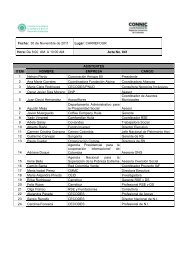Setting new standards - Friends Life
Setting new standards - Friends Life
Setting new standards - Friends Life
Create successful ePaper yourself
Turn your PDF publications into a flip-book with our unique Google optimized e-Paper software.
FINANCIAL STATEMENTS<br />
IFRS FINANCIAL STATEMENTS<br />
EEV SUPPLEMENTARY INFORMATION<br />
Notes to the consolidated accounts continued<br />
30. Risk management objectives and policies for<br />
mitigating risks continued<br />
(b) Policy cash flow risk (including insurance risk)<br />
Policy cash flow risk consists of the following four main areas:<br />
Insurance risks:<br />
• mortality risk – risk of loss arising due to policyholder deaths<br />
experience being different from expectations; or for annuities, risk of<br />
annuitants living longer than expected (called annuity longevity risk);<br />
• morbidity risk – risk of loss arising due to policyholder health<br />
experience being different from expectations;<br />
Other risks:<br />
• policyholder decision risk – risk of loss arising from experience of<br />
actual policyholder behaviour (eg lapses, option take-up) being<br />
different from expectations;<br />
• expense risk – risk of loss due to expense experience being<br />
different from expectations.<br />
The <strong>Life</strong> & Pensions business actively pursues mortality risk and<br />
morbidity risk in those areas where it believes it has a competitive<br />
advantage in managing these risks to generate shareholder value<br />
(without compromising the interests of policyholders, and the need<br />
to treat customers fairly). Policyholder decision risk and expense risk<br />
are taken on when it is deemed financially beneficial for the<br />
organisation to do so, or where the taking of these risks is in support<br />
of the Group’s strategic objectives.<br />
Underpinning the Group’s management of policy cash flow risk is:<br />
• adherence to an approved underwriting policy that takes into<br />
account the level of risk that the Group is prepared to accept;<br />
• controls around the development of products and their pricing; and<br />
• regular analysis of actual mortality, morbidity and lapse experience<br />
which feeds into the development of products and policies.<br />
Risks in excess of agreed underwriting limits may be reinsured. The<br />
Group’s objective is to purchase reinsurance in the most cost-effective<br />
manner from reinsurers whose creditworthiness is deemed appropriate.<br />
Substantially all insurance contracts, and 60% of the combined<br />
insurance and investment contract portfolio, are written in the UK and<br />
so results are sensitive to changes in the UK insurance market and<br />
tax regime. Otherwise the Group sells a diverse range of products to<br />
a diverse group of people.<br />
Note 27 describes the main insurance contracts written by the<br />
Group and the basis of setting assumptions in measuring insurance<br />
liabilities which will take into account the risks above. The following<br />
sections describe how policy cash flow risks are managed and<br />
provide an indication of the sensitivity of reported profit to the risk.<br />
Each sensitivity has been calculated independently of the remaining<br />
risks (ie correlations between risks have been ignored).<br />
F&C insurance contracts are all annuity contracts with guaranteed<br />
payment during the life time of the annuitant at a specified level or<br />
with a specified escalation factor. They are 100 per cent reinsured to<br />
<strong>Friends</strong> Provident Pensions Limited.<br />
(i) Mortality and morbidity risk<br />
<strong>Life</strong> assurance<br />
Most insurance policies other than annuities and deferred annuity<br />
policies include life assurance. When pricing policies, an assumption<br />
is made as to the likelihood of death and this assumption is<br />
reviewed as part of the annual valuation of policies. To the extent<br />
that actual mortality experience is worse than that anticipated in<br />
pricing (and subsequently in the insurance liability valuation) a loss<br />
will be made. The risk is greater for those policies such as term<br />
assurance where the maturity or surrender benefit is small in<br />
relation to the death benefit. Other policies which have a savings<br />
element, such as endowment assurance have significant liabilities<br />
relating to the maturity benefit, particularly as the policy approaches<br />
maturity. Contractual terms for unit-linked and unitised with-profits<br />
products include provision for increases in mortality charges.<br />
Critical illness<br />
The Group writes a number of critical illness policies that pay out in<br />
the event of a policyholder’s ill health. As for life assurance, the<br />
amount payable on ill health can be significantly higher than the<br />
amount payable if the policy is surrendered.<br />
An increase in experienced mortality and morbidity will reduce IFRS<br />
profit. A 5% increase in assurance mortality and critical illness<br />
experience will reduce post-tax profit and equity by £19m (2005:<br />
£26m) before allowing for reinsurance and £8m (2005: £6m) net of<br />
reinsurance. This takes into account the impact from increasing the<br />
provision for future mortality as well as the impact from actual<br />
experience. A 5% reduction in assurance mortality and critical illness<br />
experience would increase post-tax profit and equity by £18m (2005:<br />
£22m) before reinsurance and £7m (2005: £4m) net of reinsurance.<br />
Income protection<br />
Income protection policies pay a regular level of benefit if the<br />
policyholder is unable to work due to incapacity for more than a<br />
specified period. The two main risks involved are an increase in the<br />
frequency of claims (the inception rate) and an increase in the average<br />
length of the claim (a reduction in recovery rate). Most income<br />
protection policies are regular premium with the premium and cover<br />
fixed at inception. Some group policies allow premiums to be reviewed<br />
but the premium rates are usually guaranteed for three years.<br />
The impact of inception rates increasing by 5% and recovery rates<br />
reducing by 5% would be a £21m (2005: £45m) reduction in post-tax<br />
IFRS profit and equity. A 5% reduction in inception rates and a 5%<br />
increase in recovery rates would increase post-tax profit and equity by<br />
about £11m (2005: £33m). The impact assumes that the reserving<br />
basis is adjusted to reflect the change in experience.<br />
Annuities<br />
<strong>Life</strong> annuities are contracts that, in return for a lump sum, pay a regular<br />
amount (usually monthly or annually and sometimes increasing at a fixed or<br />
index-linked rate), until the death of the policyholder. As a result, if annuitants<br />
live longer than expected on average, profits will reduce. In many cases the<br />
annuity is guaranteed payable for a fixed term (usually five years) even in the<br />
event of death. Many policies are written on joint lives so that when the<br />
first life dies the benefit continues, sometimes at a reduced level. These<br />
features tend to reduce the volatility of results to random fluctuations<br />
in experience but not the impact of a general increase in longevity.<br />
148 <strong>Friends</strong> Provident Annual Report & Accounts 2006

















